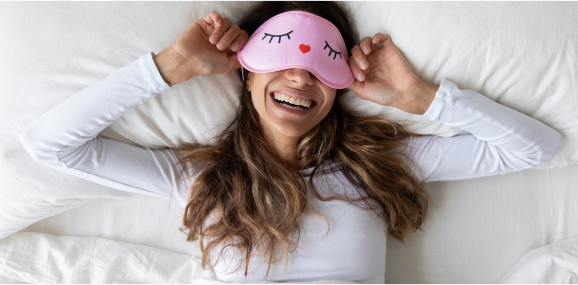Sleep is one of our most important biological functions and is absolutely imperative to our overall health.
Restful sleep allows our bodies to recharge, rebuild, and reset after the demands of the day and help prime us for the next one. This restorative process also helps keep our immune system strong.
But what is sleep exactly? What is going on in our bodies when we shut our eyes and rest our heads on our pillows at night?
Let’s take a look at the science of sleep and what you need to know.
What is the Purpose of Sleep?
Is sleep purposeful? Or is it merely something we do just because? Well, in a way it’s kind of both. Sleep is most definitely purposeful and we do it because we must.
While scientists do have all sorts of theories about the physiology of sleep, one purpose for why we sleep is clear: We have to, it’s a biological imperative.
For one thing, sleep is essential for good health. We spent one-third of our lives doing it.
There are multiple biological processes and sleep stages that are happening while we are snoozing the night away:
- During sleep, the brain is working hard to store new information, consolidate memories, and rid itself of waste.
- Cellular restoration happens during sleep. While we sleep the body repairs cells, works to restore energy, and releases various hormones.
- Sleep affects immunity. During sleep the body produces cytokines, important protein messengers for immune defense.
Sleep and Our Emotional Well-Being
While it is easy to single out the physical importance of sleep, we can’t forget the implications for our mental and emotional health. During sleep, the brain is still active and is producing important regulatory hormones, which are vital to our emotional state.
The Anatomy and Science of Sleep
Sleep is an extremely dynamic and complex process. To date, scientists and researchers are still learning about the biological and physiological processes of sleep.
One thing is clear, inadequate hours of sleep increases your risk of certain health disorders, including cardiovascular disease, Alzheimer’s disease, high blood pressure, and depression.
From a physiological standpoint, several structures in the brain are involved in the process of sleep. Let’s take a look at some.
Hypothalamus and SCN
The hypothalamus is one of the most important structures involved in sleep. This peanut-sized structure is located deep within the brain and contains groups of nerve cells that help control sleep. It also contains the suprachiasmatic nucleus (SCN), which plays a pivotal role in the circadian rhythm, also known as the circadian clock, and the sleep-wake cycle.
Brain Stem
Another structure that has a role in the sleep process is the brain stem. Located at the base of the brain, the brainstem helps control the transitions between wake and sleep by aiding the hypothalamus. It also helps produce gamma-aminobutyric acid (GABA), an essential chemical that reduces the activity of arousal centers, helping promote sleep.
Pineal Gland
The pineal gland is perhaps one of the most important structures involved in the sleep process. It receives signals from the SCN and is responsible for the production of melatonin. Melatonin is considered the sleep hormone.
Amygdala
The amygdala, an almond-shaped structure in the brain, plays a key role in regulating emotions and brain wave patterns. It becomes increasingly active during the REM sleep cycle. Sleep deprivation can disrupt this process, leading to mood and emotional imbalances.
Other brain structures involved in the sleep process include the thalamus, cerebral cortex, basal forebrain, and the midbrain.
The Biological Mechanisms of Sleep
There are good reasons why you like being awake during the day and like sleeping at night. This is because your body is regulated by internal biological mechanisms, some may refer to these as your “internal clocks.”
Circadian Rhythms and Your Internal Clock
Our bodies are equipped with their own clock — well, sort of. This biological clock is composed of circadian rhythms, which refer to the physical, mental, and behavioral changes that occur over a 24-hour period.
Circadian rhythms help our bodies carry out necessary biological functions, like wakefulness, metabolism, and hormone regulation. It also helps regulate the sleep-wake cycle, which is integral to sleep health.
The sleep-wake cycle is controlled by environmental factors, being directly influenced by environmental cues like daylight. It is in sync with the 24-hour cycle of day and night, and blue light from electronic devices can disrupt it.
For example, during the day exposure to light makes the SCN send signals to stop melatonin production, the result is alertness and wakefulness. At night, once light fades, the SCN triggers the pineal gland to start melatonin production once again.
Sleep-Wake Homeostasis
The internal mechanism responsible for the regulatory functions of sleep is sleep-wake homeostasis, or the homeostatic sleep drive. This essentially keeps track of your need for sleep and acts as the body’s self-regulating system.
It helps remind the body to sleep and gets progressively stronger as the wakefulness period gets longer. It also helps you sleep longer and more deeply after periods of sleep deprivation.
The Sleep Cycle and Stages of Sleep
There are two different types of sleep: Non-rapid eye movement (NREM) and rapid eye movement (REM). The body progresses through these two different types multiple times within a night.
This progression is known as the sleep cycle. There are four stages of sleep within the sleep cycle. Generally, the average person will progress through the sleep cycle somewhere between four to six times in a given night.
The Four Stages of Sleep
Stage 1 of the sleep cycle: The first stage of the sleep cycle involves NREM sleep. During this stage, certain processes in the body begin to slow down — heart rate, breathing, muscle tension, and eye movement — as you move from wakefulness to sleep. Brain activity also decreases.
Stage 2 of the sleep cycle: Also NREM sleep, Stage 2 is typically the longest stage. Heart rate and breathing continue to slow as eye movement becomes virtually still, and body temperature drops.
Stage 3 of the sleep cycle: The third stage of NREM sleep is referred to as deep sleep, or slow-wave sleep. The body’s processes are at their lowest levels and eye movement has ceased. It is in this stage where the most restorative sleep occurs, lasting roughly 20 to 40 minutes each cycle.
Stage 4 of the sleep cycle: The last stage in the sleep cycle is REM sleep. This generally occurs about 90 minutes after you fall asleep. During this final stage, your heart rate, breathing, and eye movement will increase slightly. It is during this stage where dreaming and memory consolidation occurs.
How Much Sleep Do You Need?
The amount of sleep that you need depends largely on your age, and the needs of teens and elderly people are different. As you age, your sleep patterns, needs, and demands will change.
Long story short: There is no magic sleep number, and some people need to spend less time asleep than others.
However, experts do offer sleep recommendation amounts for adults:
- Adults (18 – 60 years) – 7 hours or more per night
- Adults (61 – 64 years) – 7 to 9 hours per night
- Adults (65 years and older) – 7 to 8 hours per night
Quick Tips for Better Sleep
- Set a sleep schedule and stay consistent, waking and going to sleep at the same times every day.
- Avoid large meals, caffeine, alcohol, and nicotine late in the day and especially before bed.
- Exercise at least 20 to 30 minutes during the day, but not before you turn in.
- Put down the electronics before bed, blue light exposure from a tablet, movie on TV, or phone might disrupt sleep later in the night.
- Have a relaxing routine 30 minutes before bed to help wind you down from external stimuli (e.g. print book, warm bath, etc.).
- If feelings of restlessness make sleeping difficult, try the Sleep Pod, as it provides gentle compression throughout the night, helping to calm and relax you.
Conclusion
Sleep is a dynamic process that has important implications for our overall health. The science of sleep is complicated, involving internal biological clocks, self-regulating processes, and multiple stages.
We may not understand all there is to know about sleep, but there is one thing we know without a doubt: We can’t live without it.
Sources:
Physiology of Sleep - StatPearls | NIH
Sleep and immune function | NIH
Generation of circadian rhythms in the suprachiasmatic nucleus | Nature

































500,000+ happy customers